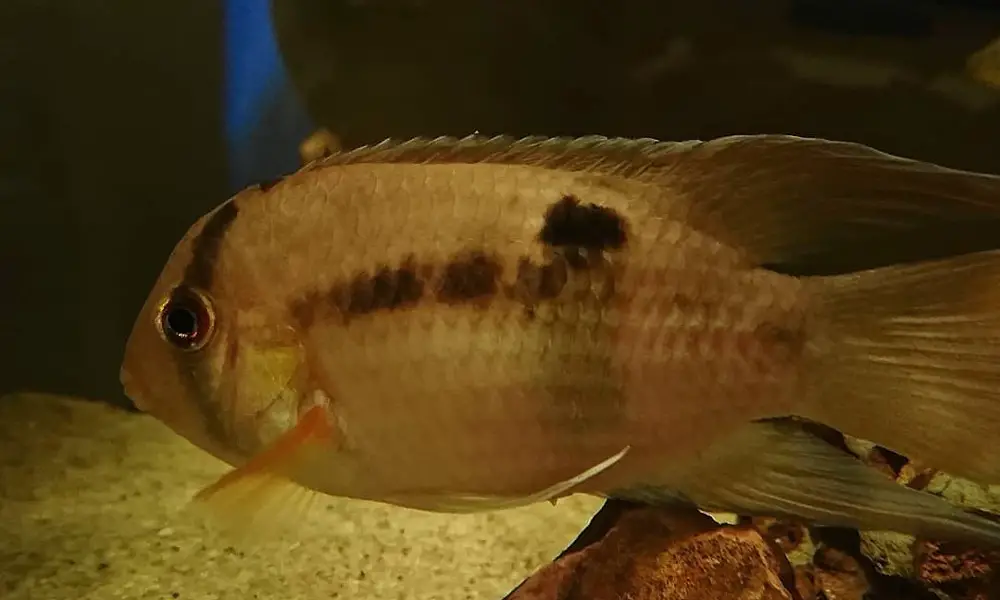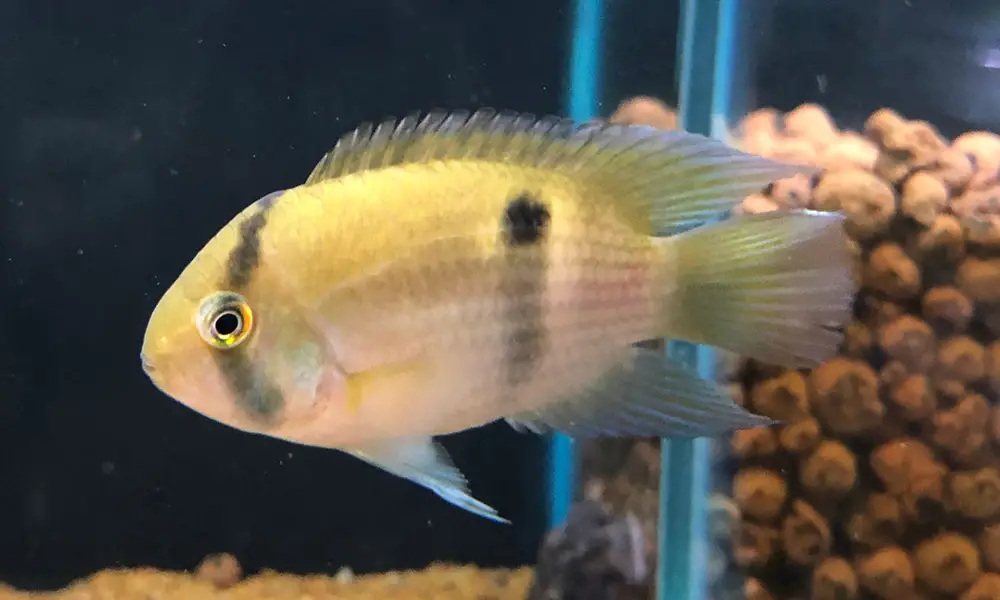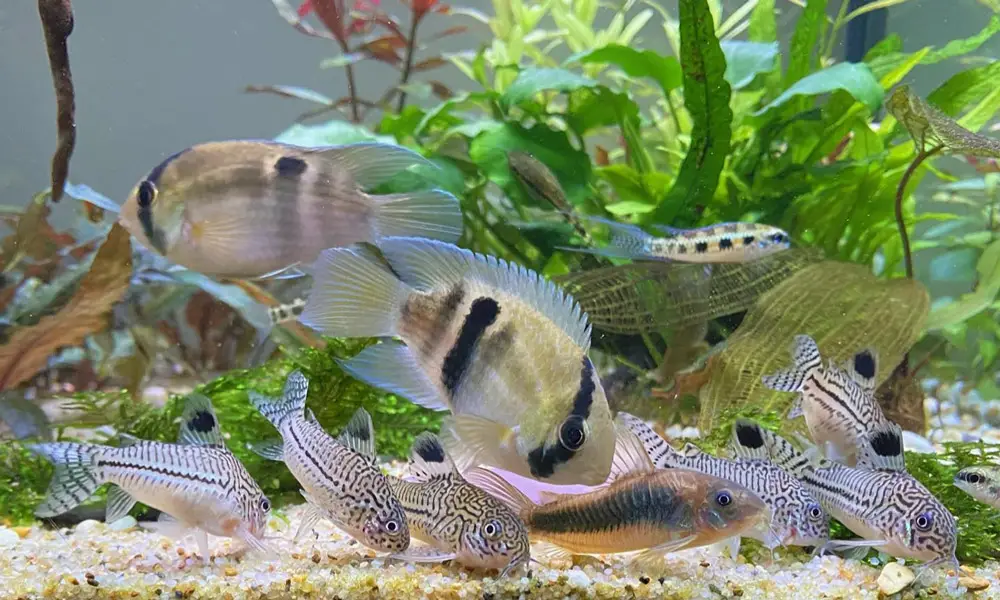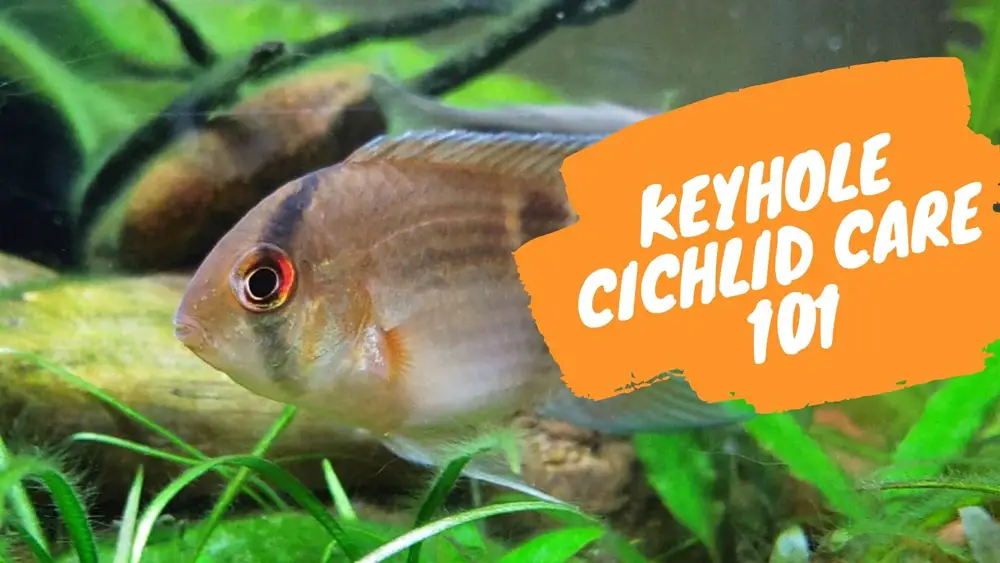The keyhole cichlid (cleithracara maronii) is a unique looking and rather friendly freshwater fish native to South America.
These fish are popular among beginner fishkeepers because they are easy to care for and have a distinct keyhole marking on their body.
But if you’re standing in the fish store thinking about adding this beauty to your tank at home, you have to understand their specific needs. That’s why we put together this ultimate guide on Keyhole cichlid care.
This guide goes over all the essential information about keeping these fish happy and healthy. I am confident that you will be prepared to take care of your very own keyhole cichlid by the time you finish reading this guide!
So let’s jump right in and learn more about these fantastic fish.
Species Description

The keyhole cichlid (Cleithracara Maronii), which originates from the tropical river basins in The Guianas in South America, is the only species in the genus Cleithracara.
While most members of the Cichlid family are notorious for their aggression, that’s not the case with the keyhole cichlid. These fish have a peaceful temperament that can be housed with a wide variety of different friendly species.
Keyhole cichlids are one of the beginner-friendly fish you can have in your tank. Their easy going nature makes them an excellent choice for those just getting started with the Cichlid aquarium, especially since they require less work on aggression management.
| Scientific Name: | Cleithracara Maronii |
| Common Name: | Keyhole cichlid |
| Origin: | South America |
| Temperament: | Peaceful |
| Care Level: | Easy |
| Lifespan: | 7-10 Years |
| Size: | ~ 4.3 inches |
| Temperature: | 72 – 81°F |
| PH: | 6.0-8.0 |
| Water hardness: | 12 – 20 |
| Diet: | Omnivorous |
| Minimum Tank Size: | 55 gallons |
Lifespan
How long do keyhole cichlids live? The average Keyhole Cichlid lifespan is anywhere between 7 and 10 years in captivity! If you want one, be prepared to commit.
That said, if you want your keyhole cichlids to live as long and healthy a life as possible, it’s important to provide them with the best care possible, including maintaining the proper water parameters, frequently changing water, offering a balanced diet, etc.
Size
How big do keyhole cichlids get? The male keyhole Cichlid can grow up to 4.3 inches (11 cm) in length, and females get up to about 3 inches (7.5 cm).
These fish are relatively small fish compared with many other SA/CA cichlid species. Combined with the fact that they don’t eat and unroot plants, making them a great choice for community aquariums.
Appearance

As its name tells, the keyhole cichlid has a black keyhole marking on its overall yellow cream color body. This marking is located on the fish’s upper flank and is somewhat darker than the surrounding scales. In some specimens, it stretches out and forms a short stripe.
In addition to this distinguishing mark, keyhole cichlids have a laterally compressed body that tapers towards the tail. Another most distinguishing characteristic of this Cichlid is a black stripe running from its head.
Keyhole cichlids can change their coloration to blend in with the surrounding environment when they feel threatened. The diversification of colors can vary a bit on the tip of their dorsal fin and outlining the tail fin.
Sexing
The gender of the keyhole Cichlid is difficult to tell apart, especially in young fish. The mature males grow larger than the females and develop extended tail fins.
Temperament & Behavior
Keyhole cichlids are usually shy, peaceful fish that can be found in schools if kept in a large enough aquarium. They seldom show much aggression to other tank mates, making them excellent for community tanks.
When they feel threatened, they can change their color to black or dark green as a form of camouflage to blend in with their surroundings.
However, they will become territorial during spawning season and defend their nests aggressively. So it’s essential to provide enough space for each keyhole cichlid in your tank.
Keyhole Cichlid Care
Whether you’re a seasoned fish-keeper or a newcomer to Cichlid aquarium, Keyhole Cichlid care is relatively easy. With a bit of knowledge of their specific needs, you can keep these fish thriving for years to come!
In this section, we go over the key aspects of keyhole cichlid care that you need to be successful in keeping them.
Tank Size
The minimum tank size for a single keyhole Cichlid or a pair is 30 gallons. If you plan on keeping in the group, a 40 gallons breeder tank or a 55 gallon fish tank would be best. Of course, a larger aquarium would be better.
We recommend keeping no more than six keyhole cichlids per tank. Keyhole cichlids are small, active fish and like to have plenty of space to swim around.
Water Parameters
In their natural habitat, keyhole cichlids live in low altitude and acidic water. They are hardy fish that can withstand most water conditions as long as you avoid extremes.
You should only introduce them to already cycled tanks and make regular water changes so you can keep these fish healthy.
Here are the important water parameters to follow:
- Water temperature: 72 – 81°F
- pH levels: 6.0-8.0 (Avoid rapid changes)
- Water hardness: 12 to 20 dGH
Plants and Substrate
When you’re planning the decor of your tank, try and mimic their natural environment as best you can.
Start with the substrate of your tank. A soft sandy substrate is preferred if you want to breed your keyhole cichlids because this species is a substrate spawner. To recreate their natural habitat, you should arrange leaves, branches, and flattened rocks on the substrate.
You can add plants for decoration; Keyholes rarely eat or dig plants like many large South American cichlids.
Decorating the aquarium with rocks and driftwood is also a great idea so that you can create hide places to help your fish feel safe and comfortable, especially in a community tank with semi-aggressive species.
Lighting & Filtration
As with all fish, keyhole cichlids need adequate lighting and filtration in order to thrive.
The keyhole cichlid live in slow-moving water, so make sure your filter isn’t too strong, or else they’ll be uncomfortable and under stress.
What do Keyhole Cichlids Eat?
It is important to vary their diet as much as possible to ensure they receive all the nutrients they need.
In the wild, keyhole cichlids primarily eat insects and other small invertebrates. However, in captivity, you can feed a wide variety of food, including flake food, freeze-dried bloodworms, and brine shrimp.
To help prevent diseases, add more fiber to your fish’s diet by feeding them vegetables. They will enjoy eating chopped cucumbers and blanched peas.
If you’re looking for a high-protein snack that will increase the growth rate and boost the color, bloodworms, frozen shrimp, brine shrimp are all good options. Make sure that you’re only feeding them as treats. (1-2 times a week max).
I have used the New Life Spectrum Thera+A for years, and keyhole cichlids really like this food. The ingredients in this pellet food are extremely high quality, much better than the Hikari. The best formulas for enhancing the color of your cichlids.
Keyhole Cichlid Tank Mates

Keyhole cichlids are an excellent bet for those looking to make their community aquarium more interesting. These fish will harmonize well with most other small species and be kept in peace even with many other South American cichlids with a similar disposition.
You’ll definitely want to avoid putting small tetras with mature keyhole cichlids as they could eat the little guys.
For a medium-size tank, I recommend only getting the pair of keyholes with a group of schooling fish. Suitable tank mates include:
- Corydoras catfish,
- barbs
- Giant danios
- small Rainbowfish
If you want to create a cichlid-species community tank, a group of keyhole cichlids won’t have any problems living with the following fish as long as the tank is big enough and have numerous hiding places:
- Rainbow cichlid
- Ram cichlid
- Blue Acara
- Angelfish
Keyhole cichlids tend to be aggressive when spawning. For this reason, you should set up barriers in the tank or move the pair to a breeding tank.
Breeding
The Keyhole cichlid is a monogamous, biparental substrate spawner. They will lay their eggs (up to 400 eggs each breeding) on a flat surface such as a rock or piece of wood. The female usually stays close and watches over the eggs while the male guard the territory.
After the eggs have been fertilized, the parents will care for them until they hatch. They will remove any unfertilized eggs and clean the area around the eggs. The fry will be free-swimming in about a week and can be fed newly hatched brine shrimp or crushed flake food.
If you want a pair for your tank, I recommend letting 6-8 juveniles grow up together and form their own pairs. As soon as the pairs start pairing off, you can separate them. They will claim a territory and defend it fiercely from others.
What Do You Think?
You’ve learned all you need to know about Keyhole cichlids. Now it’s time for decisions.
Keyhole cichlids are docile and shy, making them popular among beginner fishkeepers. These fish also don’t eat plants or burrow, so they’re excellent additions to planted aquariums.
If you have any questions about this species, please feel free to contact us.
